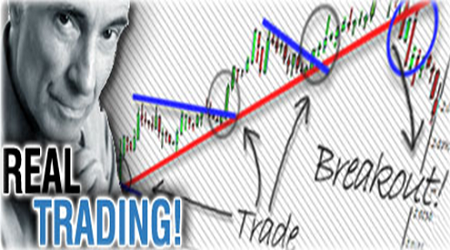
In this chapter I will explain the process taking place prior triggering a position. Let me explain it a little bit further: the job of a trader is similar to that of a detective. Before jumping into action, meaning entering a trade in the case of a trader or arresting a suspect in the case of a detective, there is a long job of investigation, sniffing around, considering different hypothesis, analyzing evidences, etc. Just as a detective doesn’t quite get out there to arrest the first folk walking by, a trader doesn’t quite pull out a chart and enters a position right away. Like I said before, there are plenty of things to do before that and that’s exactly what I will explain on this chapter.
Here we go…

So, this is a trend-following system, right? Nice, nice, but… how exactly do we determine whether we are in a trending market or not?
Well, some people use trendlines, some others rely on Bollinger Bands, some others look at the ADX indicator, etc. Every trader has his bullets. I personally use what I call the Three Simple Moving Average Trend Filter , which sounds very grandiloquent but in all fairness it’s pretty simple: grab a plain chart devoid of any indicator, trendline or anything else and plot three moving averages: the 30 simple moving average of the close (SMA hereafter), the 50 SMA and the 100 SMA. That’s all I use to determine trends.
Now, have a look at the following two charts:

click to enlarge

click to enlarge
Regardless of the SMAs, it’s obvious that the first chart is moving in a clear uptrend whereas the second chart is moving sideways. Fair enough, you don’t need moving averages to see that. So, what do we need the 3 SMAs for then? Because they provide us with invaluable information about the overall health of the trend!
But I am getting ahead of myself here. First of all, please watch the following video about the 3 SMA concept and its rules, and we will discuss it later on.

I am aware that at the beginning you might feel apprehensive to “un-train” your brain and switch from trendline-drawing to SMA-relying, but over time and with a little bit of practice you will soon realize how utterly easy is to spot out healthy trending charts. Also, I know that the condition #6 (harmonic swinging price formation off the area between the 30/50 SMA) might be a not as intuitive and easy to gasp as the other five conditions. That’s why I have decided to expand on this subject a little bit more in detail, so please watch the video below for further insight on this hairy topic.

Alright, has that cleared things up a little?
So, how can the 3 SMA Trend Filter help us identifying the overall health of a trend? Well, as we have seen on the video, how price action may develop in relation with the SMAs can assist us in that matter. But let me dig into this topic in detail:
1) If price action throughout the last trading sessions has remained most of the time in the right side of the 50 SMA (above if in an uptrend or below if in a downtrend), then we can safely assume that bulls are solidly in charge of the uptrend (or bears in case of a downtrend). Conversely, if price sneaks up and down all along the 50 SMA, we can assume that the trend lacks the horse-power needed to distance itself away from the 50 SMA. Have a look at the video below:

You see? Even though we were in a clear uptrend making higher highs and higher lows, price kept diving below the 50 SMA quite stubbornly over and over again at every retrace. Not only that, but also every subsequent retrace showed a larger dent into the 50 SMA. Remember the analogy on the video: you don’t want to mess too much with the 50 SMA – the 50 SMA is like a cat: you can play with it here and there in a mild way, but if you keep teasing it and pulling its tail, sooner or later you will get scratched.
In a way, the 50 SMA resembles the 61% Fibonacci level: when you see that the retrace is digging into them, raise your eyebrow and take a moment to re-asses the strength of the trend.
Moral of the story: as pointed out in the video, a quick piercing onto the 50 SMA is alright as long as it doesn’t happen too often and it’s only for few pips and for a brief time. When you begin to get multiple bars closing below, let the alarm bells warn you in advance that the trend might be losing steam.
2) Violating the 100 SMA is the best warning you could get that we’ve gone into DEFCON-5 status and market might be switching gears. I don’t care if, in an uptrend, I can draw a dozen trendlines all pointing upward – if the 100 SMA is breached through it means that the bears are fighting the bulls back in rage. Just go ahead and plot the 100 SMA in any trending chart and you will see that in order to stab the 100 SMA, price has to go a long way off its orthodox trending swinging pattern, probably breaking one or two trendlines in the process.
I cannot make it any clear folks: if the 100 SMA is breached, the trend is seriously jeopardized. Stay out for the time being.
After the following paragraph you can watch a video on this topic.
3) SMA parallelism: when SMAs are parallel to each other, it’s a clear indication that market sentiment is generally in agreement as of where price should be heading to. As soon as you see SMAs crossing each other, most likely the 30 SMA (the fastest of all three) crossing over the 50 SMA (the second fastest), consider it as an early warning that we might be entering either a time of consolidation or simply a change in the trend altogether.
Just as stabbing the 100 SMA raises the red flag, so does a SMA crossover. If you’re following a set up for an entry but, upon retrace, the 30 SMA crosses the 50 SMA, you must be disciplined enough to drop it and search somewhere else. There is no need to enter second-best setups guys, there are plenty of valid opportunities in the market. Do not be afraid or sad to let one setup go if all the ducks don’t fall in line.
Now let’s watch the following video about how a violation of the100 SMA or a 30/50 SMA crossover warns us in advance that the trend might be jeopardized.

Please folks, for your own trading sanity, “listen” to the market and to the SMAs, they warn us about the overall market sentiment in advance. You don’t need complicated indicators or high-tech systems to be able to read trends. You just need three silly lines, and listen carefully to what they are trying to tell you.

4) The area of dynamic support and resistance ™ (not really TM’ed, but anyway…): you cannot believe how powerful the band between the 30 SMA and the 50 SMA is when it comes to hold the retraces in a trending market. It’s like the area between the 38% and 61% Fibonacci retraces: most of the retraces in a sound trend fall into that area. Do you know why the 30 SMA and 50 SMA do work as levels of support/resistance in trending markets? OK, here goes the big secret: because large players moving enormous trading volume (fund managers, traders at investment banks, etc) use them themselves to place their limit orders in the market. How do I know? Because a fund manager himself told me so some years ago.
Now, that area can also help us determining the health or the “perfection” of a trend. Let’s assume we are in an uptrend, with price scoring higher consequent swing highs and higher retrace lows. Alright, if those retrace lows are bouncing off the 30/50 SMA area, or at least most of them are, then we are in a perfect trending scenario. In the other hand, if the retrace lows don’t even touch the 30 SMA, we might be in an over-momentum’ed market with a high grade of buying euphoria, which is always dangerous because when the fall eventually takes place (and it WILL take place, trust me) will be quite sharp and vertical. In the other hand, if retraces systematically plummet below the 50 SMA by a good margin, perhaps even nearing the 100 SMA territory, it’s a clear symptom that the Bulls can’t quite hold the Bears back – Bulls are indeed in charge, but Bears are untamed and on the loose and may regain control of the situation at any time.
Let’s now watch me rumbling on about the famous area of dynamic support and resistance; it might clear things up a little bit.

Do you believe now in the power of the dynamic area of support/resistance?




Alright, now we understand what the 3 SMA Trend Filter is about and how to use in order to determine whether we are in a healthy trending market or not. Good, what next Hector? Well, now we are going to apply that 3 SMA Trend Filter to real charts in order to select our first selection of pairs, meaning the charts we will be monitoring for next trading session.
The Pairs Selection is the proccess of selecting the trading setups that I may find suitable to trade from the 3 SMA Trend Filter perspective. Every morning I comb through 28 different currency pairs in order to find out which ones are showing the right conditions to search for trading opportunities. Moreover, I also scan those currency pairs in different time frames because what might look as a range bound chart in the Daily chart, might as well look trending in the 1-hour time frame.
I personally follow 28 currency pairs in 4 different time frames each. That’s 112 combinations or 112 different charts. You can always find a few charts out of those 112 with the SMAs meeting all the conditions and therefore ready to be traded, or at least ready to search for entries.
But Hector, how long does it take you to comb through 112 different charts every morning?!?! Between 30-to-40 minutes. How is that possible? Let me tell you another secret: I have my own personal Custom Indicator coded by myself that tells me at every moment which currency pairs and in which time frame are showing the SMAs fulfilling the 6 conditions explained before on the first video of this chapter!
Let me show you a video as of how the indicator works. Don’t worry, it’s very simple in its functioning but it’s a God sent because it reduces the pre-trading homework duties a great deal.

You see? Basically, I pull out my Trend Scanning Dashboard indicator, then I manually check those currency crosses showing either a green or red square on the Dashboard, and finally I cherry-pick the four or five best looking ones according to the 3 SMA Trend Filter conditions, ditching all the rest, and thus having my initial Selection of Pairs for the day with the handful of setups showing a high potential of giving out a profitable trade.
You can download my Custom Indicators for MetraTrader 4 platform at the annex chapter of this trading course.

So now we have picked the best looking pairs and time frames in the market for the upcoming trading session.
The next step is to verify that those pairs selected on the previous stage find no impediment from the longer time frames that might turn our trade belly up. The reason as of why we check on the longer time frames is because longer time frames are usually more significant than the shorter ones, meaning that if we have conflicting biases on two time frames, the longer time frame usually prevails. A trendline in the hourly chart holds less weigh than a trendline on the daily chart should them clash onto each other in opposite directions.
For example, let’s assume that we find a beautiful up-trend on a particular currency pair in the 4-hour time frame with all the SMAs falling in place and they should, but we are about to re-test the previous high for the year as seen on the Daily or even Weekly chart. Well, we might see a bounce down from that level and thus stopping the 4-hour uptrend to a halt. At the end of the day, that level had already worked as resistance in the past, so why couldn’t it do so once again? Better be safe than sorry guys, so if upon checking the longer term charts you see conflicting signals to your desired direction, it’s best to pass on that setup for the time being.
So basically what we will be searching for in the longer time frames are levels of support/resistance, trendlines, previous swing high/low, or any other element of Technical Analysis coming against our direction, and if we find anything significant enough we will ditch the set up altogether.

Once we have verified that our selected pairs show no contradicting signals from the longer time frame charts, pat yourself on the back because… congratulations, you have your final Watch List for the day ready to be traded!

As I always say, trading off price action is all about buying support and selling resistance. That’s the essence of it. So now that we have our Watch List ready, we want to know at what precise level of support we want to buy from or resistance we want to sell from.
Since we’re buying support (or selling resistance) we want to have as many elements of support (or resistance) coming together in our aid. What I am basically talking about here is Levels of Confluence of support/resistance. This is a crucial concept which requires further elaboration.
A Level of Confluence, let’s assume of support for example, is a level where a number of elements of support come together within few pips of each other. The more elements the better because each of them adds further strength to that level. Here goes an analogy: in a soccer game, the more different players you pack up in your defense the more difficult it’s going to be for the rival team to break through your defense line and score a goal, isn’t it? Well, support and resistance works in a similar fashion. The more elements you place around one particular area, the more difficult is going to be for price to breach it through.
The elements of support/resistance I seek for are:
1) The Area of Dynamic support/resistance. As you know guys, I always look to base my trades on bounces created at that area.
2) Fibonacci retracements, the 38%, 50% and 61% levels. I personally don’t pay attention to the 23% or 76% levels.
3) Trendlines
4) Counter trendlines
5) Previous swings highs and lows
6) Previous breakout points. For example, if we have just broken below a channel bottom, in the future that channel bottom (former support) will now act as resistance. Also works for sideways range tops/bottoms or triangles tops/bottoms. Once price breaks out from any congestion area, look out for that breakout element to work as support/resistance.
7) Round numbers: 1.2000, 1.2050, 1.2100, 1.2150, etc. Round numbers do work as support and resistance from a psychological point of view because many traders set their limit and stop orders around those round numbers, and thus price is bound to react in some way to them.
But let’s watch a video explaining this topic in detail, shall we?

You see? Basically, you search for any level within the Area of Dynamic support/resistance where few of the above-listed elements fall together within few pips of each other. Then you wait for price to retrace down to the whereabouts and zoom into the shorter time frames searching for a bounce off it and an entry in the direction of the main trend.
Those Levels of Confluence off the Area of Dynamic support/resistance are my daily bread and butter as a trend-trader. They work wonders, trust me.

Now there is only one thing left…

As you probably know, almost every day there is a fundamental economic announcement being released. Financial analysts of all sorts public their expectations for the data outcome and thus the market has more or less an idea of what the announcement should come out like. However, from time to time the data comes out deviated from the analysts’ expected figure and the charts chaotically spike up and down to re-adjust the current market price to the actual released data. Believe it or not, it happens quite often and the market reaction to such deviations can be potentially devastating to any trading position open at that precise time, especially intraday trades since their stoploss is usually rather tight and there’s a real possibility of those stoplosses being triggered by the news spike.
So, before entering a trade, have a look at the news releases being scheduled for the day. The best place to keep track of the upcoming economic calendar is the Forex Factory Forums website (www.forexfactory.com). They classify the different announcements by their impact upon the markets or volatility. Many of the news coming out don’t carry that much impact upon the markets, so I personally only pay attention to those that are labeled as “orange” or “red” volatility (meaning medium to high impact), discarding the “yellow” ones (low impact). Every morning, once I have my Watch List for the day, I check the Forex Factory calendar to see if there is any significant news coming out in any of the currencies that I have selected for the day, and if so how should I plan my way around that.
As a general rule of the thumb, you don’t want to be in a position when the news come out unless your stop loss has been moved to breakeven already. Like I said before, the news can spike a chart for 40+ pips within seconds, and it’s impossible to know before hand in which direction will the spike shoot towards. Basically, entering a trade prior the news is hardcore gambling, so don’t do it. Some people try to take a guess on whether the news will come out better or worse than expected based on this or that article they’ve read on Bloomberg and whatnot. That’s downright gambling guys as it is impossible to know before-hand the outcome of the announcement. Do you want to be a trader or a gambler?
I personally impose myself a two-hour blockout limit prior the news to make sure that I am not caught up by the spike before I can move my stop to breakeven! Trades off the 4-hourly or Daily charts are not that vulnerable to news as their stoploss and time frame scope are indeed larger, but if you’re trading the intraday you don’t want to be in an unprotected position when the bomb’s dropped. Do yourself a favor and move the stoploss to breakeven prior to the news: if you’re in the wrong side of the market you will get kicked out without a loss, and if you happen to be in the right one, your position will get propelled in your desired direction. Conversely, if the news catches up with your trade and showing a small loss, close out. Better to close at a small loss that can be made up for in the next trade than risking getting knocked back to -40 pips within few seconds.
Moreover, do not hesitate to exit at a minor loss if, by the time the news come out, your position hasn’t moved yet a distance enough to move stop to breakeven. It’s better to exit at a small loss that can be easily made up in the next trade than risking a much larger loss should the news come out against our best interest.
Lastly, I also impose a 30 minutes blockout after the news if the outcome was deviated from the expected data, slapping the charts with a spike. The minutes after the spike are filled with emotional trading as people try to ride the rollcoaster up and down. So, if upon news you see the chart bouncing about like a yo-yo, give it a while (30 minutes should be enough) to cool off the euphoria.
As I always say, trading successfully in the long run is all about minimizing risks and cutting your losses to a minimum when possible. Please watch the video below about avoiding the news spike.



Well guys, so we finally have a handful of beautiful setups, we’ve confirmed that the longer time frames are not showing conflicting signals, we know at what precise level we want to buy or sell off and we also know when the news announcements are coming out so they don’t take us by surprise. It’s time to plan our trades…

Plan the trade and trade the plan… you’ve heard that before. But what does it actually mean?
The Trade Plan is like a movie script. The script writer (meaning you as the trader) decides what the actors (meaning the price) are to do in order to perform a good scene (meaning a successful trade). We have no control over what the price will do once we enter a trade, but we indeed have control over what conditions we want to see before triggering the trade. That’s what the Trade Plan is about: listing the kind of price action we want price to undertake in order to enter a trade. If price follow our script, we take the entry. If it deviates from the script, we pass. As simple as that. We are the traders, it’s our money we’re risking here, so it’s either our way or no way at all. You must tell price: I want you to do this, this and then that. Otherwise, there’s no deal!
Alright, the elements every Trading Plan should include are:
1) What’s price doing? Is it consolidating or taking a breath after a nice thrust up? Is it stalling at the Area of Dynamic support/resistance after the retrace? Is it bouncing with momentum off a previous swing high/low? Are we making higher highs and higher lows? Are we making lower highs and lower lows? Are we ranging within a triangle? Have we perhaps broken out from a triangle?
Analyze what price is doing or has been doing as of lately. It’s important to understand what’s happening in the market right here and right now. Yes, we know that we are trending (remember that before having gotten to this point we have already settled that we are in a trending market as per the 3 SMA Trend Filter rules), but what is actually happening right now?
2) Where do we want to buy/sell from? what’s the level of support (or resistance) we are buying off (or selling off)? Basically, what level are we basing our trade upon? And what elements are lining up at that precise level?
Note the level of Confluence of Support/Resistance and wait for price to retrace to that level. If it holds the bounce, chances are that we might find a valid entry to ride a new swing in the direction of the trend. If it breaches through in momentum by a fair margin, give the setup a mighty miss.
3) When is the next economic news release for the currencies I am monitoring today and what’s my plan of action around those particular events?
This has already been explained above.
4) If I enter the trade, where will my stoploss be? And my target price? When will I move my stoploss to breakeven? Will I cash out half of my position half-way through?
Read the respective chapters on this course for further details on pre-trade and in-trade management.
5) What do I want price to do in order to pull the trigger? What type of price action formation do I want price to undertake? If I am trading a breakout-type formation, will I enter upon the first breakout or will I wait for the first pullback?
Conversely, what must price do for me to ditch this set up? What if the breakout doesn’t happen in my direction? What if price breaks below my Level of Confluence of support? What if we break below yesterday’s low on this uptrend?
For every setup I follow, I write down a script in detail with different ways that particular setup could possibly unfold in the near future, and which ones will make me enter the market and which ones will force me to give them a miss.
Yes, yes, I know – it seems complicated and too much info to keep track of. But trust me if I say that it’s not that difficult guys, it’s just a matter of getting accustomed to the whole process. Once you have developed a few Trade Plans, you will breeze through them within few minutes because most of them are carbon copy of each other. Since I am a trend trader, most of the setups I personally trade resemble each other dearly, so the respective Trade Plans for each setup are rather similar too. That’s why once you have worked a few of them out, you will see that it becomes a mechanical process of analyzing the chart, take notes of all the elements of relevance and write down a quick script with the possible unfolding scenarios.
I tell you what: in order for you to have a clearer picture of what a Trade Plan actually is, I have recorded my Trade Plans for one of my live trading sessions. I reckon that by showing you an example of a real Trade Plan you will be able to gather a clearer understanding of how to develop your own plans.
Plan the trade and trade the plan folks… it’s CRUCIAL for any successful trader.



Well, we’ve made it. We’re now ready to actually take some trades… We have scanned all the charts in search for trending markets. We have selected some nice looking setups. We have made sure that the longer time frames don’t show any conflicting signal. We know where our levels of heavy support/resistance are. We are aware of when the important economic news are coming out. We have assigned a Trade Plan to each setup…
The trading session is about to open…
It’s time to get our hands dirty…
Well, that’s all for this free chapter #1 🙂
If you have enjoyed this first chapter, I believe you will also find the next seven chapters very interesting as they follow a similar structure: all the theory concepts explained in simple, bullshit-free and easy-to-understand language over a number of detail-rich videos, followed by yet more videos where those concepts were applied in real live trades!
Moreover, you will access for free my custom trend-scanning indicator, which was coded exclusively for me by a professional programmer. This indicator filters trending from non-trending scenarios no matter the currency pair or time frame, so it’s indeed a God-sent in order to find and ride healthy trends for a profit!
If you would like to have access to the rest of the chapters of this course, the cost is a one-time fee of US$ 197. And remember: there’s a 60-day money back guarantee, no questions asked!
Ordering is quick, easy and safe. Simply click on the payment logo down below, select your choice of payments (PayPal or Credit Card) and you’re good to go!



















